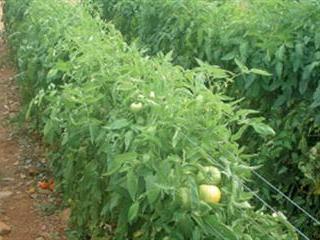
It also means you’re likely to have a number of companies trying to push their varieties on to you. Instead, you need to take a step back, as it were, and consider the factors which should be taken into account when choosing a tomato variety.
First you have to choose the growth type. ‘Indeterminate’ varieties continue growing until conditions, which include disease, cause them to stop. ‘Determinate’ varieties stop growing at a certain point. Instead of making new shoots, they will, at this point, produce flower trusses, which means that new growth stops here.
‘Semi-indeterminate’ varieties, meanwhile, grow slightly longer than the determinate varieties. The current tendency in SA is to go for indeterminate varieties. These are considered to be more economical and grow well in tunnels or protected environments. Growing under plastic means less disease, while warmer night temperatures enable the crop to grow in close to optimum conditions.
The cost of the set-up, including the medium the plants are grown in, dictates that the longer they’re in production, the more the cost is spread over a greater volume of fruit. Indeterminate varieties in these conditions are also pruned to single or double stems, making spraying and management much easier. Determinate varieties aren’t pruned as you need a number of side-shoots to produce fruit. To have such varieties in a tunnel, then, would create many complications.
Outdoors, tall or indeterminate varieties require longer poles and more layers of wire or string, meaning more labour and higher costs. Furthermore, in some areas, strong winds make using indeterminate varieties inadvisable as the plants are more easily blown over. On the other hand, harvesting is less intense and spread over a longer period with indeterminate varieties, and this may suit some producers.
Size and shape
The next step is determining the size and shape of fruit your target market requires. Tomatoes can be round, flattened or elongated, and all have a place in this country. A visit to the proposed marketing outlet is therefore essential to be sure you produce exactly what’s required. Nowadays, most outlets also specify that the fruit should have a long shelf life. Long shelf life can involve the ripening inhibitor (rin) gene. The parent which confers this quality is a yellow-orange colour when ripe.
When this is crossed with a red tomato, the resulting hybrid ripens more slowly and usually also has a slightly orange colour. Taste is compromised, but until the public demands a better taste (with long shelf life), this suits both the farmer and middleman. Varieties without the rin gene, but with a long life, tend to be red earlier on, and the consumer often tends to consider such fruit as ‘too ripe’ (and therefore having a shorter shelf life). But this misperception is starting to wane as more such varieties reach the market.
Diseases
The next important consideration is the disease package. This varies tremendously from area to area. Certain diseases are absent from many areas and makes choosing a variety much easier. If you’re planting into a sterile medium in a tunnel and the irrigation water is clean, then you may not require eelworm resistance or resistance to some soil-borne diseases.
Generally, the greater the disease package, the higher the seed price.
This brings me to the next point – the cost of the seed. Hybrids can set you back from R2 000/ha to more than R20 000/ha. Needless to say, the higher priced seed will have to provide value for money, either through certain resistances, much higher yields or through producing tomatoes that conform to a market requirement.
Contact Bill Kerr at [email protected]. Please state ‘Vegetable production’ in the subject line of your email.











